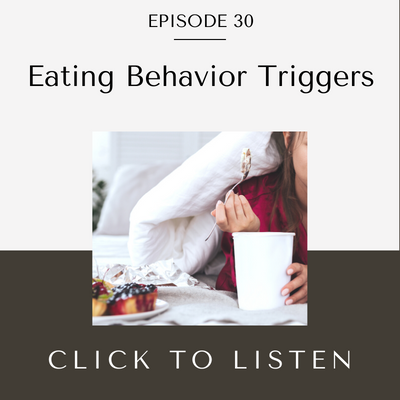Part 1: Eating Behavior Triggers
Listen in over the next 3 weeks to this 3-part series, where I’m teaching you how to address each component of the behavior sequence.
The behavior sequence is the sequence of events (trigger, behavior and reward) that must occur over and over again to form a habit.
So to break a bad eating habit, you must do the behavior sequence less frequently, which means you need to weaken it as much as you can.
In this episode (part 1), I’m sharing how to find all of your specific eating behavior triggers and how to “treat” several of them.
That way, they don’t prompt you to do the eating behavior you’re trying to break.
What You’ll Learn in This Episode:
- Why finding your triggers to specific eating behaviors is important
- How to deep dive into finding all your triggers
- What needs to be done to “treat” these triggers
- How to decrease some common triggers that will come up for you

Listen Below:
Related Episodes:
Next Steps: Take Control of Your Eating Habits & Lose Weight Naturally
Imagine the freedom and peace of overcoming emotional eating, overeating, and mindless eating… so you can achieve lasting weight loss.
Ready to break free for good?
Together, we’ll create a personalized pathway that works for you. Bringing clarity, relief, and encouragement. Click the button to start.
Full Episode Transcript:
Part 1: Eating Behavior Triggers
Hi there, welcome to the podcast. Thanks for joining me today, despite probably all of the things on your list with Christmas coming up. It’s quite easy to go into a feeling of overwhelm around the holidays, but hopefully listening to my relatively soothing voice will help calm you down to some extent. But more importantly, this episode will give you lots of information on how to find your eating behavior triggers.
If you don’t know what your eating behavior triggers are, it’s a lot harder to try to change the eating behaviors and habits themselves. That’s one of the main things that is part of the process of breaking bad eating habits.
Finding the eating behavior triggers and weakening those or completely removing them. Typically, when you weaken them, the objective is to weaken them to the point that they are gone.
However, there are always going to be some triggers that come up that you don’t have full control over. That’s where developing the skill to not react to those triggers is extremely helpful and important period which of course, is what I help my clients with.
So, in this episode I’m going to help you find out what your specific eating behavior triggers are. You may be aware of at least one of the things that triggers a particular eating behavior or habit. You may not be aware of any of them. You may also be aware of a few, but not all of them. But don’t worry, that’s what I will help you with in the next 20 minutes or so.
Alright, so first you need to start out knowing the exact eating behavior that you would like to try to find the trigger for. Sounds really obvious right? However, what I see often is that many women are a little unclear as to the specific eating behaviors because they generalize all of their eating behaviors as “bad.” If this is you, don’t worry, this is common.
You may find yourself confused about what exactly is triggering what, because you’re sort of clumping all you were eating behaviors into one, and that’s going to make it difficult to find specific triggers and match them up with specific eating behaviors.
So, you’re going to look at one specific eating behavior at a time. You’re then going to find the trigger for that specific eating behavior.
And by specific eating behavior, I don’t mean just overeating in general or emotional eating in general. I mean for example, eating a candy bar every day at work, or eating half a bag of chips five nights a week while on the couch. Whatever the specific eating behavior that you’d like to try to break, you need to isolate out and ask yourself “what am I feeling right before I do this eating behavior? Right before I eat the candy bar or half a bag of chips?”
The feeling can be something as simple as desire. Maybe you see candy bars all the time at work in the vending machine, and you have the desire.
Desire is a feeling. That desire might then trigger you to get a candy bar from the vending machine and eat it.
For the chip example, maybe it’s boredom. Maybe sit down on the couch, turn on the TV, and because this isn’t nearly as stimulating as maybe some conversation with someone or reading a really great book, you might feel bored, which triggers you to get up and grab the bag of chips from the kitchen. Done over and over again, eventually this will become a habit. It’s automatic. When this becomes a habit and is automatic, it just seems so much less in your control.
Really once it becomes a habit, your brain has just made the whole process of feeling the trigger, doing the behavior, and feeling some sort of a reward from the behavior, usually pleasure or avoidance of discomfort, and makes this process just go more quickly. That’s the whole purpose of your brain wanting to develop habits, is for conservation of energy and speed.
Once an eating behavior does become a habit, like I said, the whole process just becomes a little bit quicker, a little bit more automatic. There’s still always going to be an eating behavior trigger. Something has to prompt you to do the eating behavior. The most direct trigger is going to be a feeling that drives the eating behavior or action.
That feeling in your body is always going to be coming from a thought that you’ve produced in your mind. So, once you ask yourself what was it that you were feeling before you did the action, the eating behavior, you can then find out why you were feeling this way if you want to.
This is actually really helpful information when you work backwards, because you become aware of all of the things that come into play to make the eating behavior actually occur. And having this awareness, is really key to “solving” the eating behavior or habit.
So once you find what feeling it is that’s driving the action, think of this as really useful information. Let’s go back to the candy bar example. If the feeling is desire, what is the thought that triggered that desire?
It could be as simple as I could really go for a Snickers right now. Now, did you think of that thought out of the blue? Or did you think that thought when you walked by the vending machine? This is just more information. All of this information helps, because the more information you have, the more things you know you need to address.
If you just had the thought, “I could really go for a Snickers bar right now”, you could ask yourself why? Or if you were my client, I would ask you why, and we would get to the bottom of why you really wanted that Snickers bar every day. Maybe it’s because you’re feeling unappreciated at work, and the candy bar either acts as a “reward” or it helps you temporarily feel a little bit better.
Let’s do another example. Let’s say you find yourself eating seconds at dinner every night. Then, you end up feeling overly full. You notice that you’re slowly gaining weight. So, the behavior is eating seconds. What is triggering you to do this?
Now, sometimes it’s tough to find the feeling. This is why I wanted to give you this example. Sometimes, it’s easier to find the thought.
For example, if you see everyone else taking seconds, you might have a thought, “I’m gonna do the same.” Or, maybe you don’t see everyone else taking seconds, but there will be something else triggering you. Maybe it’s just seeing the food on the table and thinking that you don’t like to have leftovers in the fridge. The thought can be anything.
When it comes to finding your eating behavior or eating habit triggers, all of this is very useful information. It’s sort of like when you go to the doctor’s office, the doctor, PA, or nurse practitioner will be listening for all the pertinent information he or she needs to make a diagnosis, and also will ask you some pointed questions as well.
Some of these things you may not have thought about. Some of these things you may not realize are even important at all. But the health care provider needs a lot of this information to make a diagnosis and then of course develop a treatment plan.
Sometimes they need to collect more data by doing blood work or imaging studies, and then you might have a diagnosis and treatment after more data collection. But it’s all very important and helps to really pinpoint what it is that’s actually the problem and establish all the possible treatment options you can do for that problem.
Okay, so now I just want to help you in being able to find some more useful information about your triggers. So of course, you’re going to think about the feeling that you had right before the eating behavior, the action. Also, it’s good to think about the thought you had that generated that feeling within your body.
It’s also very helpful to know what triggered the thought. So, what triggered the thought can be anything. Any sort of circumstance or thing in the outside world. It can be a person, seeing a plate of cookies, smelling pizza, your job, your past history. Now just to be clear, these things don’t CONTROL your thoughts. Only you control your thoughts. They come from your brain.
Now of course you can’t always control your circumstances. You can’t control another person. You might not be in complete control of seeing a plate of cookies or smelling pizza. Your past history you can’t control either, because it’s in the past. And certain things about your job you may not be able to control, however, the great news is that you can learn how to not react to these things in such a way that will prompt you to do the eating behavior that you’re trying to decrease or stop completely.
That’s why it’s really important to understand your eating behavior triggers, but also understand that you don’t need to just completely take away all these triggers either. Some of them you can take away or decrease, which I’m going to share with you how to do this in just a moment, but some of them you also need to just learn the skill of having the trigger exist, but not letting it bother you.
Not letting it bother you to the point that you end up reacting and eating the food that you’re trying to decrease or avoid. This is one of the things that I help with. I also of course help with taking away or decreasing the triggers, making the behavior harder to do, planning ahead, and all the other things associated with behaviors and habits, but all of that combined, is going to be what really allows you to effectively break bad eating habits and in a realistic way.
You develop the skills to not just react. You develop the skills to be in control. And, the lovely part about that, is that it translates to lots of other areas in your life.
Okay, so some triggers that you can decrease or even take away are visual and even olfactory meaning smell.
Now, you may not think you have control of the circumstance of the plate of cookies that someone may have set out in the break room at work, or the pizzeria you walk by on your lunch break, but you do have some control. So instead of focusing on what you can’t control about these. What can you control?
You can control what you do. You can control what you think, feel, and actually do or don’t do. So, you would brainstorm a couple of options for the plate of cookies that someone may have set out in the break room at work right? You might be able to move them to a different location so that they’re not so visually obvious. You might change your route so that you won’t walk by them every single time you have to go to someone else’s office.
Now this is where also just training your brain to not be triggered by this any longer is going to be helpful as well. It just makes life easier for you. But in the meantime, you can decrease the trigger by not seeing it as much.
As for the pizzeria that you pass by on your lunch break, you can walk a different route, right? You don’t have to walk that same route. you can control your actions.
Also, if you know that you’re feeling hungry around lunchtime and you typically go for a walk that might result in you walking by the pizzeria or smelling the pizza down the road, you can eat your own lunch that you brought from home ahead of time, so that you’re not even hungry for more food.
Whenever you’re hungry, any sort of trigger is going to just be heightened significantly. If you’re not hungry, because you’ve already filled up on a healthier lunch, yes, the pizza might smell good still, however you’re going to be less likely to go in and buy a slice.
For snacks at night, you can make these snacks less obvious. If they have to be in your house in the first place, which I would actually question, even if you feel like they have to be in your house for your kids or your significant other, you probably have more control over that then you think.
Now certainly, you don’t have control of other people buying chips and bringing them into your house to eat them, but if you’re the purchaser of the chips, you might really want to question if you need to be keeping them in the house, if they’re that much of a problem for you.
At least maybe not have them around in the beginning when you’re trying not to be triggered by them, and then once you do learn the skill of not necessarily reacting and being able to process your emotions, allow cravings to come and go, all of that, you could potentially probably have the chips in your house again.
And again, this is all on an individual basis, what you want your end results to be, your personality type, etcetera.
So, try to make the eating behavior trigger less visually obvious or make it less likely that you will be triggered by a smell, by controlling what you can control. You can make a trigger less visually obvious by not putting it front and center or leaving it out on the counter, right? You can make it less visually obvious by either not buying it at all, or if it is in the house, sort of burying it in the back of the pantry, so you’re not seeing it every time you open the pantry.
I like to enjoy an occasional imperial stout in the fall or the wintertime, so I’ve found that if I am keeping them in the refrigerator in our kitchen, every time I open up the refrigerator door, I see it and have the thought “oh that would be really yummy right now.”
However, if I leave those in the refrigerator that we have downstairs in our basement, I am not seeing the stout every time I open the refrigerator door, because I barely go down there and use that refrigerator. Therefore, I’m not getting that visual trigger very often and if it’s out of sight it tends to be out of mind. Especially the longer it is out of sight.
Alright, so the last thing I leave you with, is once you start discovering some of your eating behavior triggers, I want you congratulate yourself on doing this. You played detective and you got some really great information through your digging. This is only going to be helpful for you. What I don’t want you to do is start thinking negatively about what is triggering you. Your brain might want to go to judgment. That’s completely normal period I find that’s especially true for women, and especially for career women or perfectionists.
So next week, be sure to join me, because I’m going to be doing part two which is all about making the eating behavior harder to do, if it’s one you’re trying to break, or making it easier to do if it’s one that you’re trying to form, such as eating oatmeal at home for breakfast, instead of grabbing a breakfast sandwich and coffee at Starbucks.
Thanks so much for listening, and if you don’t want to do all of this alone, that’s what I am here for. You can book a free one-on-one consult with me so that I can find out where exactly you’re at, what your goals are, and I can share my solution in getting you there. You can book a free consult here: https://katemjohnston.com/consult.
Take care, and I’ll talk with you soon.

KATE JOHNSTON
Eating Habits & Weight Loss Coach
Helping career women break free from emotional eating, overeating and mindless eating.
Start feeling more healthy, confident and free by clicking the button below.
